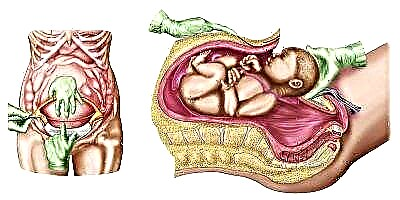
Thanks to the development of medicine, a cesarean section is not a contraindication for the second, third and subsequent pregnancies today. But bearing a baby after a cesarean has its own nuances, which is why doctors recommend that women take a break between the first and second births. About how long it takes to give birth to a second baby, if the first one was born surgically, we will tell you in this article.

The opinion of doctors
There is a medical recommendation that is heard by all women whose birth took place by caesarean section. They are advised not to get pregnant again, have an abortion or carry a child for two years after the operation. 2 years is a period that was not invented for intimidation and uncommon advice, this period is the result of many years of research by obstetricians.
Unfortunately, not every doctor finds enough time and desire to tell every mother who is discharged from the hospital about why the term of the restriction is exactly that. And that actually goes a long way in planning your next pregnancy.

How successful it will be, how it will proceed, depends on many factors, among which the state of the internal scar on the uterus, left after the first operation, is also important. And it is formed for a long time and gradually.
In the first weeks after cesarean section, adhesion and formation of new myocytes occurs. New cells of the uterine tissue take the place of those injured during surgical dissection. If a sufficient number of such cells are formed, the scar will be wealthy and reliable, it will allow you to carry the next child without problems, and may also be quite suitable for independent childbirth.
If, under the influence of a variety of reasons - infections, complications of the postoperative process, inflammation, for immune reasons, more connective tissue is formed, which does not differ in elasticity, then the scar will be insolvent.

The primary scar formation continues for two months after surgery. After this period, most women stop postpartum discharge, after another month or two, or almost immediately, the menstrual cycle normalizes, and sexual activity resumes. But the catch lies in the fact that the processes of formation of the internal scar are still ongoing and they last at least two years.
6-7 years after the operation, the scar becomes coarser, even if initially it was quite elastic and well-off. And this also negatively affects the bearing and birth of a child. Therefore, the optimal time for a new pregnancy, from the point of view of doctors, is considered to be from 2 to 6 years.

How can you give birth?
Repeated childbirth, if the time interval between the first and second caesarean section, the woman sustained properly, can be carried out in two ways. Either a repeated elective surgery will be scheduled, or the woman will be allowed to give birth on her own. It is no longer possible to give birth to a third or fourth child after two or three caesarean ones.
The choice of the method of childbirth remains with the woman. Doctors can only give recommendations. So, patients will be admitted to natural childbirth who:
- have a well-to-do, uniform, non-thinned scar on the uterus after the first operation, the thickness of the scar is at least 3-4 mm;
- a horizontal suture remained from the first operation, dissection was performed in the lower uterine segment;
- the postoperative period after the first CS passed without complications;
- the woman did not have abortions between pregnancies;
- the onset of the second pregnancy proceeds without pathologies;
- the baby is located in the uterus with its head down and its weight does not exceed 3.6 - 3.7 kg;
- The "child's seat" is not located in the area of the scar;
- the age of the woman in labor is less than 36 years old.

It is important that the cause that led to the first operation has been eliminated by the time of the second pregnancy.
If a woman was operated on due to a narrow pelvis or deformation of the pelvic bones, then it is unlikely that something will change in the second pregnancy. In this case, as in all those not covered by the above list, a second planned cesarean section is prescribed. A woman who is allowed to give birth may refuse and ask for a second operation if she is psychologically frightened by the prospect of physiological childbirth with a scar on the uterus.

A planned cesarean section is repeated at almost the same time as the first. It is advisable to bring the baby to the 39th week of pregnancy. Elective surgical delivery may be scheduled between 38 and 40 weeks on any day.
If the pregnancy occurred earlier
Often, women are faced with the fact that pregnancy after the operation of the CS came before the recommended terms. What to do in this case is up to the woman herself. If she chooses to leave the baby, she will definitely need to prepare for a difficult pregnancy, which can only result in a second cesarean section. Natural childbirth is most likely not allowed.
The earlier a woman becomes pregnant, the more fears the scar on her uterus will cause. The reproductive organ will begin to grow to provide for the fetus and its needs, stretching the walls of the uterus will make the scar even thinner. The main risk is the divergence of the uterus along the scar during pregnancy.

In addition, the presence of a scar that has not yet completed the recovery processes can cause a threat of termination of pregnancy, incorrect, low attachment of the placenta. If it grows into the wall of the uterus along the line of the postoperative zone, then it is possible that the entire uterus will have to be removed during the second operation. Often the scar becomes the cause of fetoplacental blood flow disturbances, up to 45% of cases of intrauterine fetal growth retardation is a consequence of the presence of a scar on the uterus.
If it is still decided to leave the pregnancy, the woman will be monitored in the consultation as a high-risk patient. She will have to take tests more often and visit a doctor, it is possible that she will have to lie in the gynecological department several times during pregnancy. The scar will be monitored especially closely - it will be measured to prevent critical thinning that threatens to rupture.


How to plan a second baby?
If a couple is responsible for childbirth, then family planning will not be an empty phrase for her. To minimize the risks, a woman with one uterine scar should be very responsible in planning her second pregnancy.
First of all, after two years, you need to go to an appointment with an obstetrician-gynecologist, undergo a gynecological examination, get a referral for colposcopy, and take blood and urine tests. It is especially important to find out the consistency of the scar. To do this, you need to do not only an ultrasound of the pelvic organs with measuring its thickness, but also undergo hysteroscopy, sometimes there is a need to do hysterography - an X-ray of the uterus and ovaries using a contrast agent.


Even if the viability of the scar raises questions from doctors, it is not worth giving up the prospect of having a second baby. You need to find a good specialist or clinic that works with problem pregnancies, including those with inconsistent scars on the uterus. There are options, you just need to know from which starting point you will have to move to the next goal.

Reviews
There are actually quite a lot of women who became pregnant much earlier than the period recommended by doctors. Some find out about a new pregnancy a year after the operation, some - six months later, there are even those who, 3-4 months after the operation, come to the consultation to register for pregnancy.
If the pregnancy is planned, then usually women go to it no earlier than 2.5-3 years after the operation.
Confusion and fear, if the “interesting situation” came ahead of schedule, is quite understandable, because no one can give a woman guarantees that the pregnancy will proceed normally.
On the other hand, there are enough reviews on the Web about a completely safe gestation and childbirth, even if the pregnancy occurred much earlier than two years.

The attitude of doctors to such cases in antenatal clinics, according to reviews, leaves much to be desired. Most doctors simply do not want to take responsibility for a high-risk pregnant woman, and therefore it is not uncommon for women to report that they have been offered an abortion.
For details of pregnancy and childbirth after cesarean section, see the following video.



